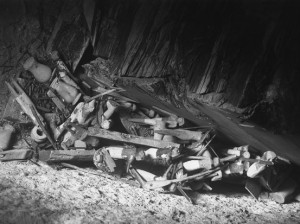 In 1915, archaeologists with the Harvard University-Museum of Fine Arts Expedition digging in Deir el-Bersha found a 4000-year-old tomb of a governor and his wife. It had been torn apart thousands of years before by tomb robbers looking for jewels and precious metals. Even the mummies were decapitated, and to add insult to injury, the robbers set the tomb on fire on their way out.
In 1915, archaeologists with the Harvard University-Museum of Fine Arts Expedition digging in Deir el-Bersha found a 4000-year-old tomb of a governor and his wife. It had been torn apart thousands of years before by tomb robbers looking for jewels and precious metals. Even the mummies were decapitated, and to add insult to injury, the robbers set the tomb on fire on their way out.
Amazingly, the elaborate wooden coffin, decorative items and mummies which the looters hadn’t deemed worth stealing back then, survived. They were in jumbled pieces, but they were still there, and thus began a hundred years of work by archaeologists to reassemble Mr. and Mrs. Djehutynakht’s tomb.
The dramatic results are now on display at the Museum of Fine Arts in Boston.
Projected on a wall, the images pull visitors into the harsh desert and the startling moments when MFA registrar Hanford Lyman Story and expedition team members blasted away enormous boulders and encountered a shaft that showed signs of fire and plunder. They dug down another 30 feet to reach the bottom, and there, among the debris, was an entrance to a burial chamber.
“Inside, they discovered a chaotic scene with objects strewn throughout the small room by robbers in search of booty,” according to museum documents. “Proving an eerie greeting for the 20th-century visitors was a linen-wrapped painted head perched on top of a coffin, appearing to observe the excavators. Propped up in the far corner was a limb-less, head-less torso.”
The central part of the exhibit shows artifacts recovered from the tomb, including the mummified head. Computerized tomography scans showed that the bones that would indicate whether the head belonged to Djehutynakht or his wife were removed during mummification. DNA tests currently being undergone might tell us more.
Another room displays the largest known collection of wooden models from the Middle Kingdom which portray people going about their business on Djehutynakht’s estate. Egyptians believed the figures at work, religion and play on 60 ships would come to life and serve their masters in the afterlife. Conservators spent 10,000 hours pieces these objects back together from thousands of shards destroyed by looters.
The highlight of the exhibit is the Bersha coffin, the brightly painted cedar outer coffin in which 3 other coffins were nested to hold Djehutynakht’s mummy. It’s presented disassembled so visitors can see the intricate hieroglyphics on the inside of the coffin, meant for Djehutynakht to read.
The MFA has a great website set up for the exhibit. There’s a slideshow of the tomb as it was found in 1915, and a neat zoomable viewer of the reconstructed artifacts. Then there’s the totally cool 3D computer scans of the mummy head (see below).
[kml_flashembed movie="http://www.thehistoryblog.com/wp-content/videos/mummy.swf" width="430" height="243" wmode="transparent" /]
Perdon. Can I ask something? What do you think about the Bosnian pyramids? 😉
I’ll believe them when I see them. 😉
Will this exhibit be traveling elsewhere in the US? :thanks:
I’m afraid not. I called the MFA and they said the objects are far too fragile to travel.
This is an EXCELLENT exhibit – I’m lucky enough to be local and the museum really did a spectacular job arranging this. The finds aren’t stunning or jaw-dropping, but even so, the display makes a real impact. Go if you can!
Ooh, how exciting! I love to get an eye witness review. As far as I’m concerned, the fact that they were even able to piece this tomb together is stunning and jaw-dropping, despite the lack of fancy gold and jewels.
This exhibit looks fascinating, really gutted it is not in my country. Is there a list of the images and coffin texts the two coffins consisted of?